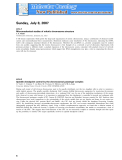
The Chemical Elements
-
The alumina refining industry is one of a number of global industries that produce process waters containing mercury. The research program detailed in this dissertation focuses on processes for removing mercury from Bayer digestion condensate streams. Bayer refinery digestion condensate is chemically unique because it exhibits high pH and is chemically reducing, thermodynamically favouring the presence of elemental mercury.
 192p
192p  runthenight05
runthenight05
 01-03-2023
01-03-2023
 5
5
 3
3
 Download
Download
-
It was demonstrated that Poly(p-Xylylene) (PPX) could be prepared from α,α’-Bis(Alkoxy or Aryloxy) –p-Xylenes via chemical vapor decomposition (CVD)- method. This is one-step process and there are side products by the CVD-process. This effect depends both on the CVD- condition and the properties of the starting monomer. The structure and thermal behavior of the material were characterized by FTIR, UVvis spectroscopy, elemental analysis, wide-angle X-ray diffraction, DTA and DSC.
 14p
14p  12120609
12120609
 01-06-2020
01-06-2020
 17
17
 1
1
 Download
Download
-
The thesis aims to successfully fabricate NaHAp films doped separately and simultaneously with microelements: sodium, magnesium, strontium, fluorine, copper, silver and zinc on 316L stainless steel substrate to meet the requirement of screw bracing bone. Study on physicochemical characteristics, study on toxicity, antibacterial ability and bio-compatibility of NaHAp films separately and concurrently with trace elements.
 27p
27p  xacxuoc4321
xacxuoc4321
 11-07-2019
11-07-2019
 20
20
 3
3
 Download
Download
-
Mer belongs to the Tyro 3 family of receptor tyrosine kinases (RTKs). Together with Axl and Rse, the three RTKs are believed to play important functional roles in the male gonads because gene knockout male mice lacking all of these receptors are infertile. In the present study, postnatal expression of Axl and Rse in mouse testes decreased during maturation while expression of Mer increased age-dependently during testicular development.
 12p
12p  system191
system191
 01-06-2013
01-06-2013
 43
43
 2
2
 Download
Download
-
A series of thylakoid membrane proteins, including PsbX, PsbY and PsbW, are synthesized with cleavable signal peptides yet inserted using none of the known Sec/SRP/Tat/ Oxa1-type insertion machineries. Here, we show that, although superficially similar to Sec-type signal peptides, these thylakoidal signal peptides contain very different determinants.
 11p
11p  system191
system191
 01-06-2013
01-06-2013
 46
46
 4
4
 Download
Download
-
Haematopoiesis, the differentiation of haematopoietic stem cells and progenitors into various lineages, involves complex interactions of transcription factors that modulate the expression of downstream genes and mediate proliferation and differentiation signals. Commitment of pluripotent haematopoietic stem cells to the erythroid lineage induces erythropoiesis, the production of red blood cells. This process involves a concerted progression through an erythroid burst forming unit (BFU-E), an erythroid colony forming unit (CFU-E), proerythroblast and an erythroblast....
 12p
12p  research12
research12
 01-06-2013
01-06-2013
 47
47
 4
4
 Download
Download
-
The citric acid or tricarboxylic acid cycle is a central element of higher-plant carbon metabolism which provides, among other things, electrons for oxidative phosphorylation in the inner mitochondrial membrane, intermediates for aminoacid biosynthesis, and oxaloacetate for gluconeogenesis from succinate derived from fatty acids via the glyoxylate cycle in glyoxysomes. The tricarboxylic acid cycle is a typical mitochondrial pathway and is widespread among a-proteobacteria, the group of eubacteria as de®ned under rRNA systematics from which mitochondria arose. ...
 16p
16p  research12
research12
 01-06-2013
01-06-2013
 41
41
 3
3
 Download
Download
-
We have isolated and studied the cloned sigma factors SASIG1-3 from mustard (Sinapis alba). In functional ana-lyses using both promoter and factor mutants,the three recombinant proteins all had similar basic properties but also revealed differences in promoter preference and requirements for single nucleotide positions. Directedmuta-genesis of SASIG1 identified critical residues within the conserved regions 2.4 and 4.2 necessary for binding of the )10 and)35 promoter elements,respectively.
 13p
13p  tumor12
tumor12
 20-04-2013
20-04-2013
 33
33
 2
2
 Download
Download
-
The expression of the major protein kinase C substrate MARCKS (myristoylatedalanine-richCkinase substrate) is controlled by the stability of its mRNA. While the MARCKS mRNA is long living in quiescent fibroblasts (t1/2¼14 h), its half-life time is drastically reduced (t1/2¼2 h) in cells treated with phorbol esters to activate protein kinase C (PKC) or treatedwith growth factors. In a first step to study the underlying mechanism we identified both acis-element on the MARCKS mRNA and the cor-responding trans-acting factors. ...
 16p
16p  tumor12
tumor12
 20-04-2013
20-04-2013
 39
39
 3
3
 Download
Download
-
The lipopolysaccharide (LPS) ofChlamydia trachomatis serotype E was isolated from tissue culture-grown element-ary bodies and analyzed structurally by mass spectrometry and 1 H, 13 Cand31 P nuclear magnetic resonance. The LPS is composed of the same pentasaccharide bisphosphate aKdo-(2–8)-aKdo-(2–4)-aKdo-(2–6)-bGlcN-4P-(1–6)-aGlcN-1P (Kdo is 3-deoxy-a-D-manno-oct-2-ulosonic acid) as reported forC. trachomatisserotype L2[Rund,S.,Lind-ner,B.,Brade,H. and Holst,O. (1999)J. Biol. Chem.274, 16819–16824].
 11p
11p  tumor12
tumor12
 20-04-2013
20-04-2013
 39
39
 4
4
 Download
Download
-
Selenium is a trace element found in freshwater and the marine environ-ment. We show that it plays a major role in spicule formation in the demo-sponge Suberites domuncula. If added to primmorphs, an in vitro sponge cell culture system, it stimulates the formation of siliceous spicules. Using differential display of transcripts, we demonstrate that, after a 72-h expo-sure of primmorphs to selenium, two genes are up-regulated; one codes for selenoprotein M and the other for a novel spicule-associated protein....
 15p
15p  fptmusic
fptmusic
 11-04-2013
11-04-2013
 32
32
 2
2
 Download
Download
-
Serum response factor (SRF) is a MADS transcription factor that binds to the CArG box sequence of the serum response element (SRE). Through its binding to CArG sequences, SRF activates several muscle-specific genes as well as genes that respond to mitogens. The thermodynamic parameters of the interaction of core-SRF (the 124–245 fragment of serum response fac-tor) with specific oligonucleotides from c-fos anddesminpromoters, were determined by spectroscopy.
 15p
15p  fptmusic
fptmusic
 11-04-2013
11-04-2013
 43
43
 4
4
 Download
Download
-
The phosphoproteins HPrSerP and CrhP are the main effectors for CcpA-mediated carbon catabolite regulation (CCR) inBacillus subtilis. Complexes of CcpA with HPrSerP or CrhP regulate genes by binding to the catabolite responsive elements (cre). We present a quantitative analysis of HPrSerP and CrhP interaction with CcpA by surface plasmon resonance (SPR) revealing small and similar equilibrium constants of 4.8 ± 0.4 lm for HPrSerP–CcpA and 19.1 ± 2.5 lmfor CrhP–CcpA complex dissoci-ation.
 12p
12p  awards
awards
 06-04-2013
06-04-2013
 39
39
 2
2
 Download
Download
-
As a critical step of the preinitiation complex assembly in transcription, the general transcription factor TFIIB forms a complex with the TATA-box binding protein (TBP) bound to a promoter element. Transcriptional activators such as the herpes simplex virus VP16 facilitate this com-plex formation through conformational activation of TFIIB, a focal molecule of transcriptional initiation and activation.
 9p
9p  dell39
dell39
 03-04-2013
03-04-2013
 33
33
 2
2
 Download
Download
-
N-6 polyunsaturated fatty acids (PUFAs) may be associated with increased risk of colon cancer, whereas n-3 PUFAs may have a protective effect. We examined the effects of docosahexaenoic acid (DHA), eicosapentaenoic acid and arachidonic acid on the colon carcinoma cell lines SW480 derived from a primary tumour, and SW620 derived from a metastasis of the same tumour.
 17p
17p  dell39
dell39
 27-03-2013
27-03-2013
 34
34
 4
4
 Download
Download
-
Plasminogen activator inhibitor type 1 (PAI-1) is induced by many proin-flammatory and pro-oxidant factors. Among them, tumor necrosis factora (TNFa), a pivotal early mediator that regulates and amplifies the develop-ment of inflammation, is one of the strongest PAI-1 synthesis activators. Location of the TNFa response element in the PAI-1 promoter is still ambiguous.
 11p
11p  dell39
dell39
 27-03-2013
27-03-2013
 45
45
 4
4
 Download
Download
-
In vascular smooth muscle cells and several other cell types, inhibition of Na + ⁄K + -ATPase leads to the expression of early response genes, including c-Fos. We designed this study to examine whether or not a putative Na + i ⁄K + i-sensitive element is located within the c-Fos5¢-UTR from )650 to +103 containing all known response elements activated by ‘classic’ stimuli, such as growth factors and Ca 2+ i-raising compounds.
 11p
11p  galaxyss3
galaxyss3
 19-03-2013
19-03-2013
 35
35
 3
3
 Download
Download
-
Iron regulatory protein-1 binding to the iron-responsive element of mRNA is sensitive to iron, oxidative stress, NO, and hypoxia. Each of these agents changes the level of intracellular ATP, suggesting a link between iron levels and cellular energy metabolism.
 12p
12p  galaxyss3
galaxyss3
 19-03-2013
19-03-2013
 32
32
 3
3
 Download
Download
-
I will discuss experiments which probe the large-scale organization of mitotic chromosomes, using a combination of chemical modifi-cations and micromechanical force measurements. Restriction nucleases cause dissolution of the chromosome, indicating that DNA itself is the contiguous structural element of the chromosome. Therefore the non-DNA (i.e., protein) components must be isolated from one another, suggesting that the mitotic chromosome is best thought of as a network or gel of chromatin.
 12p
12p  galaxyss3
galaxyss3
 19-03-2013
19-03-2013
 40
40
 4
4
 Download
Download
-
Translation initiation of hepatitis C virus (HCV) occurs through an internal ribosome entry site (IRES) located at its 5¢-end. As a positive-stranded RNA virus, HCV uses its genome as a common template for translation and replication, but the coordination between these two pro-cesses remains poorly characterized.
 19p
19p  galaxyss3
galaxyss3
 07-03-2013
07-03-2013
 35
35
 5
5
 Download
Download
CHỦ ĐỀ BẠN MUỐN TÌM
























![Báo cáo khoa học: [Na+]i-induced c-Fos expression is not mediated by activation of the 5¢-promoter containing known transcriptional elements Báo cáo khoa học: [Na+]i-induced c-Fos expression is not mediated by activation of the 5¢-promoter containing known transcriptional elements](https://tailieu.vn/image/document/thumbnail/2013/20130319/galaxyss3/135x160/8161363693709.jpg)







